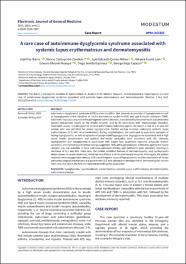Mostrar el registro sencillo del ítem
A rare case of autoimmune dysglycemia syndrome associated with systemic lupus erythematosus and dermatomyositis
| dc.contributor.author | Paz-Ibarra, José | |
| dc.contributor.author | Concepción-Zavaleta, Marcio | |
| dc.contributor.author | Quiroz-Aldave, Juan Eduardo | |
| dc.contributor.author | Kcomt Lam, Mikaela | |
| dc.contributor.author | Huauya, Edwars Gilvonio | |
| dc.contributor.author | Sueldo Espinoza, Diego | |
| dc.contributor.author | Gago Cajacuri, George | |
| dc.date.accessioned | 2023-10-17T16:08:09Z | |
| dc.date.available | 2023-10-17T16:08:09Z | |
| dc.date.issued | 2023-04-09 | |
| dc.identifier.uri | https://hdl.handle.net/20.500.13053/9553 | |
| dc.description.abstract | “Autoimmune dysglycemia syndrome (ADS) is a rare condition that presents as episodes of hypoglycemia as well as hyperglycemia and is classified as insulin autoimmune syndrome (IAS) and type B insulin resistance (TBIR). Autoimmunity plays a key role in the pathogenesis ofthis disorder, as evidenced by the presence of autoantibodies against endogenous insulin or the insulin receptor, and by its association with rheumatologic disorders. Treatment usually includes glycemic control and immunomodulatory agents. We report a case of a 31-year-old woman who was admitted for severe hypoglycemia. Further workup revealed underlying systemic lupus erythematosus (SLE) with renal involvement. During hospitalization, she continued to experience episodes of fasting hypoglycemia, as well as episodes of postprandial hyperglycemia. Hypoglycemia associated with a high serum insulin concentration and positive anti-insulin antibodies were consistent with IAS. Likewise, hyperglycemia and hypoglycemia in association with weight loss, acanthosis nigricans, polycystic ovarian syndrome, and normotriglyceridemia strongly suggested TBIR, although testing for antibodies against the insulin receptor was not available in Peru. Immunosuppressive therapy and metformin were indicated, resulting in remission of SLE and ADS. Years later, the patient exhibited features of dermatomyositis, such as Raynaud’s phenomenon, muscular weakness, heliotrope exanthema, and elevated muscle enzymes. Once again, the patient received immunosuppressive therapy. ADS is an infrequent cause of hypoglycemia, and the coexistence of its two pathophysiological mechanisms in a patient with SLE and subsequent development of dermatomyositis is even more rare. Our case is the first one reported describing this association.“ | es_PE |
| dc.format | application/pdf | es_PE |
| dc.language.iso | eng | es_PE |
| dc.publisher | Modestum LTD | es_PE |
| dc.rights | info:eu-repo/semantics/openAccess | es_PE |
| dc.rights.uri | https://creativecommons.org/licenses/by/4.0/ | es_PE |
| dc.subject | "hypoglycemia, hyperinsulinism, autoantibodies, systemic lupus erythematosus, dermatomyositis, autoimmune diseases" | es_PE |
| dc.title | A rare case of autoimmune dysglycemia syndrome associated with systemic lupus erythematosus and dermatomyositis | es_PE |
| dc.type | info:eu-repo/semantics/article | es_PE |
| dc.identifier.doi | 10.29333/ejgm/13294" | |
| dc.type.version | info:eu-repo/semantics/publishedVersion | es_PE |
| dc.publisher.country | GBR | es_PE |
| dc.subject.ocde | 3.03.00 -- Ciencias de la salud | es_PE |
Ficheros en el ítem
Este ítem aparece en la(s) siguiente(s) colección(es)
-
SCOPUS [380]


